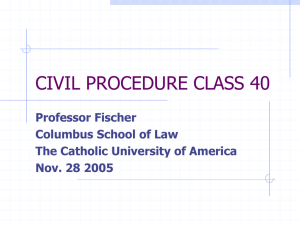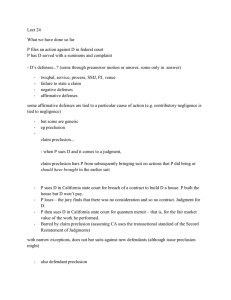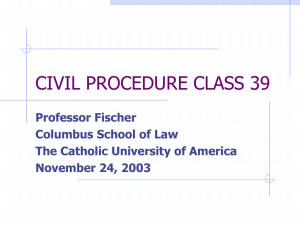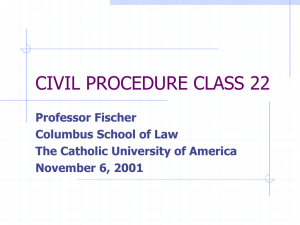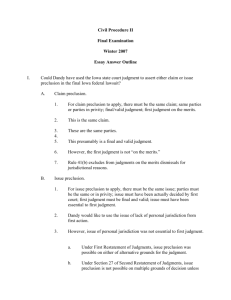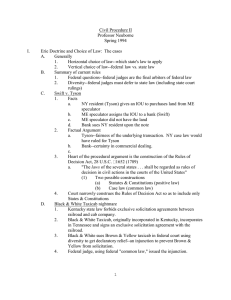Lect 32 Issue preclusion If in an earlier case an issue was
advertisement
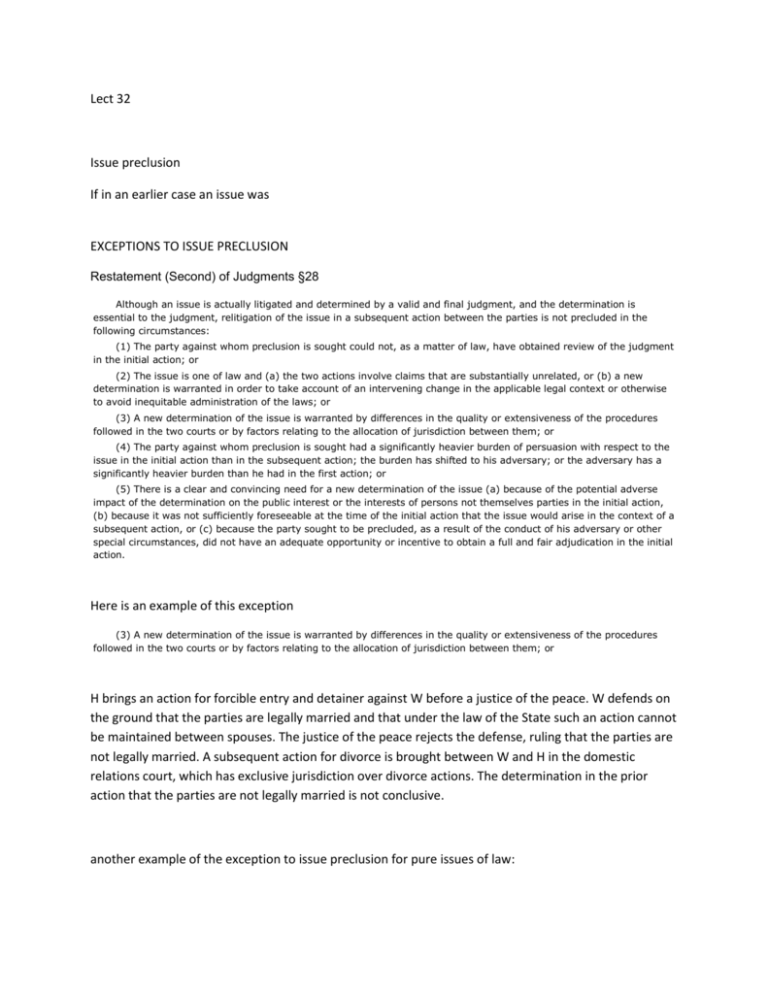
Lect 32 Issue preclusion If in an earlier case an issue was EXCEPTIONS TO ISSUE PRECLUSION Restatement (Second) of Judgments §28 Although an issue is actually litigated and determined by a valid and final judgment, and the determination is essential to the judgment, relitigation of the issue in a subsequent action between the parties is not precluded in the following circumstances: (1) The party against whom preclusion is sought could not, as a matter of law, have obtained review of the judgment in the initial action; or (2) The issue is one of law and (a) the two actions involve claims that are substantially unrelated, or (b) a new determination is warranted in order to take account of an intervening change in the applicable legal context or otherwise to avoid inequitable administration of the laws; or (3) A new determination of the issue is warranted by differences in the quality or extensiveness of the procedures followed in the two courts or by factors relating to the allocation of jurisdiction between them; or (4) The party against whom preclusion is sought had a significantly heavier burden of persuasion with respect to the issue in the initial action than in the subsequent action; the burden has shifted to his adversary; or the adversary has a significantly heavier burden than he had in the first action; or (5) There is a clear and convincing need for a new determination of the issue (a) because of the potential adverse impact of the determination on the public interest or the interests of persons not themselves parties in the initial action, (b) because it was not sufficiently foreseeable at the time of the initial action that the issue would arise in the context of a subsequent action, or (c) because the party sought to be precluded, as a result of the conduct of his adversary or other special circumstances, did not have an adequate opportunity or incentive to obtain a full and fair adjudication in the initial action. Here is an example of this exception (3) A new determination of the issue is warranted by differences in the quality or extensiveness of the procedures followed in the two courts or by factors relating to the allocation of jurisdiction between them; or H brings an action for forcible entry and detainer against W before a justice of the peace. W defends on the ground that the parties are legally married and that under the law of the State such an action cannot be maintained between spouses. The justice of the peace rejects the defense, ruling that the parties are not legally married. A subsequent action for divorce is brought between W and H in the domestic relations court, which has exclusive jurisdiction over divorce actions. The determination in the prior action that the parties are not legally married is not conclusive. another example of the exception to issue preclusion for pure issues of law: A brings an action against the municipality of B for tortious injury. The court sustains B's defense of sovereign immunity and dismisses the action. Several years later A brings a second action against B for an unrelated tortious injury occurring after the dismissal. The judgment in the first action is not conclusive on the question whether the defense of sovereign immunity is available to B. Mutuality of estoppel – still the law in Ohio & Georgia But this exception to the mutuality requirement tended to exist anyway - - - P sues employee for battery as a result of a scuffle when the employee tried to stop P from shoplifting. The employee wins. P then sues the employer on a theory of respondeat superior. The employer can preclude P from relitigating the employee’s wrongdoing, despite the fact that he is not in privity with the employee what about this one? - P sues employer on a theory of respondeat superior for battery as a result of a scuffle when employee tried to stop P from shoplifting. - The employer wins. - P then sues the employee. Issue precluded in a mutuality state? No – no indemnification problem Bernhard v B of A Nat Trust and Savings Ass’n Cal SCt 1942 J Traynor early abandonment of mutuality requirement - prior judgment in probate ct in action brought by Bernhard and other beneficiaries of Sather’s will against Cook, executor of the will - held: money not in final accounting - was a gift to Cook - as adminstratrix of Sather’s estate, Bernhard sued bank to recover money on ground that it had been paid out by bank w/o authorization - bank claimed issue preclusion – bank not a party or in privity with a party in probate action so this is nonmutual issue preclusion 1st question is Privity o in first suit Bernhard was suing in individual capacity as a beneficiary of Sather’s will o o o o Second suit she is suing in capacity as administratrix of Sather’s will Representative of Sather Since she is suing in different capacities no relationship of privity? remember a parent suing as the guardian of a child cannot bind the parent when suing on his own behalf no - privity As Sather’s administratrix she is really representing beneficiaries, since the $ will go to the beneficiaries the interests overlap could this fit into the narrow exception to the mutuality requirement? assume that bank could not issue preclude Bernhard and she won the bank would have to pay out money that it had already given to Cook - could it have demanded Cook give back the money? - if it could then Cook would be treated unfairly – if they could not the bank would have had to pay out twice But Traynor speaks very generally of nonmutual issue preclusion being permissible - all that is required is - identity of issues - final judgment on merits (notice even that is not always require) - party bound is party or in privity to party in earlier litigation NOTE: this is too lenient Book discusses 4 situations of nonmutual issue precl is the bound party as P or D in earlier action is the party invoking issue preclusion in second suit (who was not a party in the 1st litigation) a P or D in second suit - if D then defensive, if P offensive defensive - two sub-types: precluded party was a 1) plaintiff or 2) defendant in 1st suit first subtype: A sues B for infringement of his patent and loses (patent is invalid) A then sues C for infringement of the same patent. C argues patent is invalid. strongest case for nonmutual issue preclusion – this is the Bernhard case second subtype A sues B for negligence and wins (B is found negligent) B then sues C for negligence in connection with the same accident. C offers the defense of B’s contributory negligence. Still strong argument for issue preclusion, although the precluded party did not choose the forum even the fact that there was litigation in the first suit offensive plaintiff in second suit uses issue preclusion as a sword – much more problematic - two sub-types: precluded party was a 1) plaintiff or 2) defendant in 1st suit first subtype A sues B for negligence. A is found contributorily negligent. C then sues A for negligence in connection with the same accident. Second subtype A sues B for negligence. B is found negligent. C then sues B for negligence in connection with the same accident. This is the most problematic – the Parklane Hosiery case Parklane Hosiery v Shore - 1st there is a shareholders class action concerning a materially misleading proxy statement in connection with a merger - Then SEC action is for injunction against same defendant - this came to judgment 1st with finding that proxy statement was materially misleading - Shore moved for partial summary judgment on that issue in the class action, claiming issue preclusion DCt denied on ground that it would deny D a right to a jury trial Why? - SEC suit was an action in equity – no right to jury trial – fact that the proxy statement was materially misleading was found by a judge but the class action is an action at law where the D has a right under the 7th A to a jury trial the D’s argument was that he has a constitutional right to a jury trial on that issue the SCt rejects this argument on the ground that at the time the 7th A was enacted such cases of issue preclusion in an action at law due to an action at equity would have been thought permissible Ct spells out some worries about offensive issue preclusion Since a plaintiff will be able to rely on a previous judgment against a defendant but will not be bound by that judgment if the defendant wins, the plaintiff has every incentive to adopt a "wait and see" attitude, in the hope that the first action by another plaintiff will result in a favorable judgment. Thus offensive use of collateral estoppel will likely increase rather than decrease the total amount of litigation, since potential plaintiffs will have everything to gain and nothing to lose by not intervening in the first action. A second argument against offensive use of collateral estoppel is that it may be unfair to a defendant. If a defendant in the first action is sued for small or nominal damages, he may have little incentive to defend vigorously, particularly if future suits are not foreseeable. Allowing offensive collateral estoppel may also be unfair to a defendant if the judgment relied upon as a basis for the estoppel is itself inconsistent with one or more previous judgments in favor of the defendant. Still another situation where it might be unfair to apply offensive estoppel is where the second action affords the defendant procedural opportunities unavailable in the first action that could readily cause a different result. - Therefore, broad discretion – no offensive nonmutual issue preclusion - if P claiming issue preclusion could have easily have intervened in first suit but did not do so - or other situation where unfair - e.g. future litigation was not foreseeable - there was inconsistent determination of the issue in the past - or there were procedural opportunities unavailable in the first suit, - in this case? - plaintiffs could not intervene in an SEC action - besides, they did not take a wait and see attitude – they were the first to sue - future litigation about the issue was foreseeable - was already taking place - no inconsistent judgments – only one finding by the SEC - adequate incentive to litigate the issue etc. so this is a good case for offensive nonmutual issue preclusion DISTINGUISH! P sues D for negligence. P wins (D is negligent). X knew about the suit but refused to intervene. X sues D for negligence in connection with the same accident. X may not be able to issue preclude D concerning D’s negligence. - this is like Parklane Hosiery, where the fact that X did not intervene is a reason to think that he cannot take advantage of offensive nonmutual issue preclusion P sues D to put up a dam. X’s property will be flooded, but he refuses to intervene in the suit. P wins. X may be precluded to sue D to take down dam. - this is a reason to think that X is PRECLUDED from suing – this is a rare cutting edge exception (only gradually being recognized by some states) to the rule that someone cannot be bound by a judgment unless he was a party or in privity with a party in the case where the judgment was issued – Parklane is irrelevant here - NOTE that some states (e.g. Virginia) do not allow offensive nonmutual issue preclusion at all, although they do allow the defensive variety and Ohio and Ga still stick to the mutuality requirement A federal court determining the issue preclusive effect of a Virginia state court judgment will use Virginia’s approach – this is its obligation under the Full Faith and Credit statute - 28 U.S.C. § 1738 – not the Full Faith and Credit Clause of the Constitution Because it is only a statutory duty, Congress can release federal courts of their statutory duty to give state court judgments Full Faith and Credit by passing a new statute Congress did just that in the Terri Schiavo case - although there was a final valid judgment on the merits in Florida state court, which had preclusive effect under Florida law, Congress allowed the parents of T Schiavo to sue again in federal court
